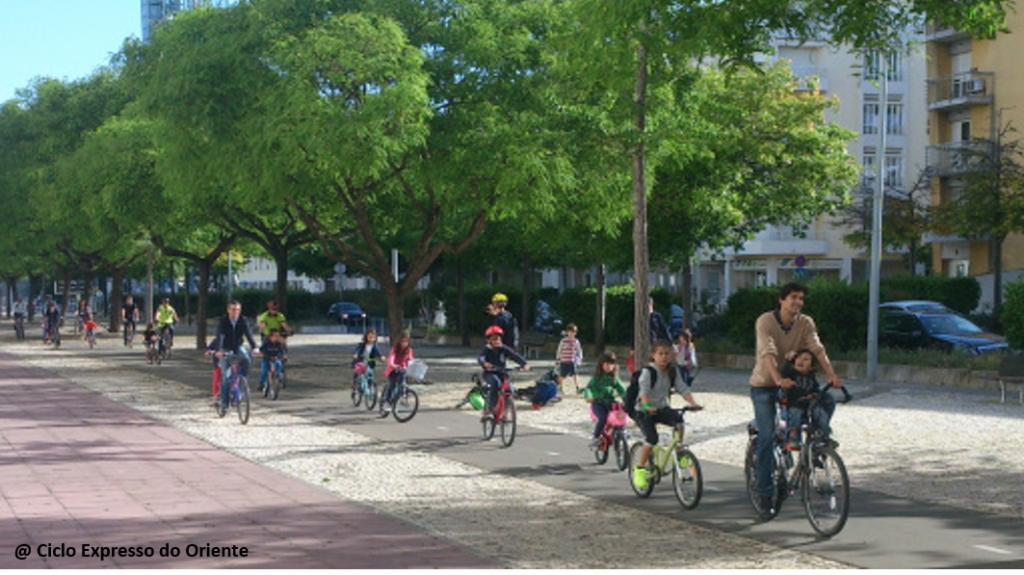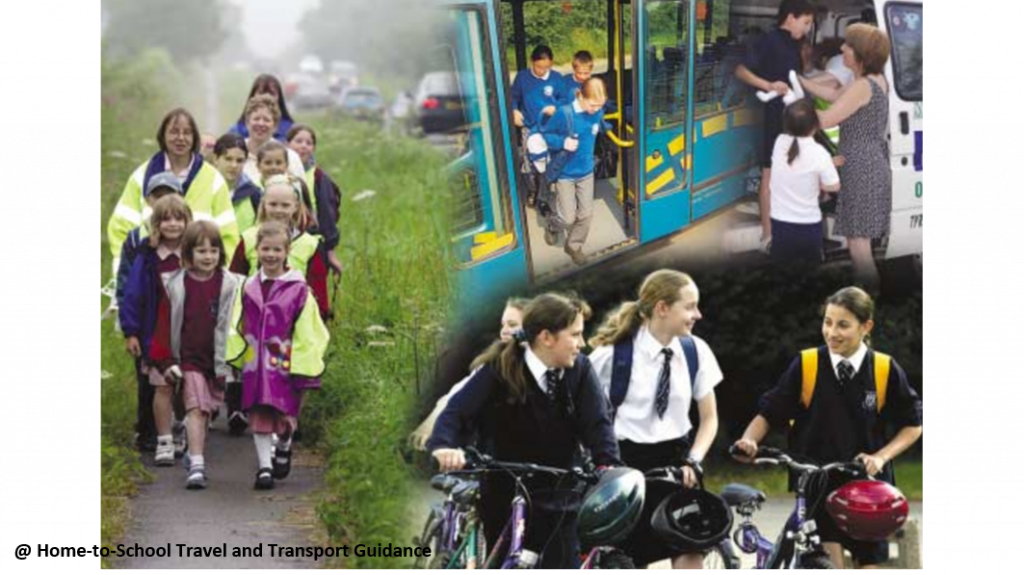
1. Presentation
School Mobility Management is an approach that promotes sustainable mobility for commuting to school, by changing mobility attitudes and behaviours of the school community, namely reducing the use of car and increasing trips by bicycle and on foot, integrating education and awareness-raising measures with planning and infrastructural measures (see list of school mobility management measures for cycling).
2. Objectives
- Promoting a shift of mobility behaviour of parents, pupils, teachers and staff for school commuting;
- Fostering active mobility and cycling in the school context;
- Promoting safe ways to schools;
- Providing the base for a mobility behaviour change in the new generations.
3. Measure’s importance
In the last decades there has been a sharp increase in the percentage of students driven to school by their parents, while the percentage of children walking or cycling to school has decreased (when a few decades ago these were the main modes of transport). This leads to serious societal impacts, such as the emergence of childhood and youth obesity, as well as environmental impacts, since home-school travel can account for up to 20% of rush hour traffic in urban areas. The focus on school children and young people and, consequently, on the adults who make up their family and educational nucleus is essential for changing travel patterns in the long term. In addition, school mobility management can provide financial savings to parents and schools, reducing parking and traffic problems around schools, reducing pollution, and providing safety and health benefits.
1. Good Practices
– The articulation between the school/ university and the local and traffic authorities is of utmost importance.
– There should be an audit of existing infrastructure to promote sustainable and cycling mobility. In cases where there is a need to improve urban infrastructure, it will be useful to collaborate with the government departments required to implement a project for cycling infrastructure (See Cycling network and Safe and efficient intersections).
– It is important to assess the effective mobility needs of the school community, notably through a mobility survey (which can be done with the involvement of students), and to identify target groups that are at a distance eligible for cycling (up to 3km for ages under 8 years; up to 5km for ages between 8 and 16 years; up to 8km for ages over 16).
– For groups that are not at a distance eligible for cycling (or walking), integration with public transport should be encouraged (See Integration of bicycle in public transport).
– The specificities of people with special needs must be met.
– The approach should be dynamic and fun in order to captivate younger people into cycling.
– Provide information and data that encourages the programme and is specific to the school community.
– Identifying, mapping and signalling safe walking or cycling routes to school/ university is a key component of school mobility management, as is the regulation of traffic around school/ university.
– Ideally the mobility manager figure should be created to coordinate the various actions and involve the whole school community.
– Schools/ universities located in the same region can promote partnerships with each other and develop coordinated actions.
– School mobility management can be done in conjunction with various curricular and extracurricular activities (in the areas of health, environment, physical education, civic education, ICT, arts, etc.).
– Planning for younger people should seek to take into account the perspective of children, including the signage at eye level and their visibility to other road users.
– It is important to monitor the adaptation of school community to the proposed changes and reformulate measures to respond to users’ needs and difficulties, without compromising sustainable ideals (See Management, monitoring and maintenance).
– Explain the principles behind the measures taken so that their need and functioning are clear (See Information).
2. Actions
 | School mobility plan The mobility plan is a tool often used to implement the various mobility management measures of the organization in an integrated and systematic way. It is a package of measures tailored to the specific needs of each school/university and aims to promote more sustainable transport choices and reduce car dependency. This plan may include: information and awareness campaigns; cycling classes; provision of changing rooms and showers; bike parking; establishing groups of cyclists; providing bicycles for occasional use; offering incentives to cycling; promoting and publicizing cycling; collaboration between municipality and schools/universities to identify the potential for improvement of their cycling accessibility; repair services, etc. (See list of school mobility management measures for cycling). |
 | Bike to school campaigns Mapping safe roads and developing strategies that encourage and enable more students to safely bike to/from school during one specific day or throughout the year. In this context, extending school insurance coverage to include accidents involving students commuting to/from school by bicycle is an important measure to enhance the perception of safety. An additional initiative may be providing cameras for children to film their commute to school and record points of discomfort / insecurity. These campaigns can be enhanced through the use of Multimedia and Social Network and Branding. Learn more: guide.saferoutesinfo.org/ |
 | Alternative mobility solutions - Bike train Organized bike ride to and from school, supervised by adults (usually a group of parents) who work with children to assure everyone’s safety and fun. Like a traditional train, bike trains may have a fixed route with agreed stops and schedules for picking/ dropping children. Note: Bike trains often rely on the volunteer work of parents, requiring constant work to guarantee volunteers throughout the school year. |
 | Educational mobility games Games are a good funny and motivating way for children to learn about their own mobility and mobility in their city. E.g.: Traffic Snake Game - www.trafficsnakegame.eu/ |
 | Managed traffic and facilities around schools Set of complementary measures, generally within the competence of public authorities, to promote the right conditions and safety infrastructure for cycling to school/ university, such as protected school zones, pedestrian and cycling infrastructure around the school, adequate bicycle parking facilities, traffic calming measures and managed traffic during schools’ starting and closing times (or the prohibition of stops at the school). (See Limited speed zones, Cycling network, Safe and efficient intersections, Car parking restrictions, Horizontal and vertical road deflections, Car Parking pricing around school/ university). |

CycleExpress – bike train, Lisbon (Portugal)
The initiative to create a bicycle train that takes children to school in Lisbon, at Parque das Nações, aims to promote sustainable mobility and to get children going to school using healthy and sustainable means of transport. It is a partnership of the parents’ association and the parish council and takes place once a week, on Fridays, through a defined route in which children can enter at the beginning or along the way, with the escort of some volunteer parents/ monitors. The initiative was recognized by the World Health Organization (WHO) and has already been replicated in the city of Aveiro with “CicloExpresso das Barrocas”.
Learn more: https://cicloexpressodooriente.wordpress.com/
1. Impacts
 | Mobility system efficiency For traffic and urban planners, school mobility management can be a cost-effective way to reduce car travel and change attitudes of pupils, teachers and families to be more favourable towards sustainable transport modes, reducing congestion and increasing cycling modal share, thus increasing efficiency of the mobility system. |
 | Livable streets These measures make the school/university surroundings calmer and increase pupils’ abilities to move (independently) on the way to school and throughout the city. In addition, increased levels of cycle safety around schools/universities mean streets are safer, more accessible and more comfortable for all users, bringing more people into the city’s streets, promoting more liveable streets. |
 | Protection of the environment Less car trips to schools/ universities, which are a major trip generation pole, reduces pollution and improves the environment. |
 | Inclusion, equity and accessibility By raising the status and removing the stigma of cycling to/from school/university and by investing in children and students, these measures increase the transportation choices for all, including lower-income and disadvantaged families, leading to more social equity. Cycling to school is also an opportunity for children to explore their community and develop social skills. However, it is important that these actions address, in a proactive way, the specific needs of the most vulnerable groups, such as those with disabilities or from economically disadvantaged families. |
 | Safety and comfort All School Mobility Management measures should be accompanied by the right safety infrastructure. Less car traffic around schools/universities increases the safety in the nearby neighbourhoods. By starting with younger people and investing in safe trips to school/university, communities become safer places for everyone. |
 | Economic value These measures often lead to reductions in spending for schools/universities and families and can foster new economic initiatives around cycling. |
 | Awareness and acceptability By starting with younger people and schools, these measures are essential to raising awareness and breaking resistance to cycling, contributing towards changing mobility patterns in the future, fostering a long-lasting awareness. |
Legend:
| Very positive | Positive | Neutral | Negative | Very negative |
2. Barriers
 | Legal In most instances, there are no legal barriers to School Mobility Management. However, the lack of school insurance coverage for traveling to school may inhibit the promotion of cycling initiatives by schools and local authorities. In the Portuguese case, there has been no governmental political will to produce the legislative change in school insurance coverage. |
 | Finance Financing requirements are relatively low, if compared to infrastructure measures. However, schools usually do not have budget for this sort of actions, requiring support from public authorities. On the other hand, these measures usually lead to cost reductions for school and families, which can be reinvested in the gradual expansion of the programme. |
 | Governance The initiative can come from public authorities (city and traffic planners, parish councils), from schools/universities or from parent or teacher associations. It should involve all persons affected: teachers and school staff, children/ students, parents, traffic or city planners, police; but tensions may arise. Sometimes getting schools, teachers and parents engaged in extracurricular actions is difficult due to different barriers (difficult prerequisites, lack of resources and interest, competition with other topics and activities). Public authorities should provide handbooks and guidelines. However, in order for these plans to succeed, public authorities need to support and interact with the school, providing both funds and technical support. |
 | Political acceptability Frequently these sort of measures are not known or have very low priority with decision makers, though generally well accepted, with the hindrance of school insurance. Any restriction to traveling by car can have high political costs. |
 | Public acceptability School Mobility Management is generally well accepted, though some parents and teachers might be hostile to the aim of reducing car use. The actions must address barriers that discourage children (and their parents), university students and teachers from cycling to school. |
 | Technical feasibility Schools or universities on their own may not have the competences to organise these measures. |
Legend:
| No barrier | Minimum barrier | Moderate barrier | Significant barrier |
3. Budget
| Area | Measure | Unit | Cost | Implementation year |
| Lisbon, Lisbon Metropolitan Area (Portugal) | Design and diagnosis of mobility plans for Lisbon schools | 19 500,00 € | 2019 | |
| Birmingham (U.K.) | Implementation of school mobility plan | 26 schools, secure parking for scooters and bicycles, showers, workbenches, staff bikes, bikes and accessories for cycling lessons and (padlocks, lights, helmets, tools) | 10 000,00£ | Data collected in 2017 study |
| Great Manchester (U.K.) | Implementation of school mobility plan | 11 schools, 834 new parking spaces, updating of 410 parking spaces, 383 padlocks, 2 mountain paths created, 1 scooter route, 3 cycling workshops, 4 bicycle storage containers, 2 bicycle transport containers, 2 shower facilities for staff and 6th graders, public space rehabilitation around 5 schools | 100 000,00£ | |
| Graz (Austria) | Implementation of school mobility plan with 40 available measures for each school to choose | 1 year and 1 school | 1 500,00€ – 1 800,00€ | Started in 2010 |
| Frankfurt, Rhine-Main (Germany) | Online School Trip Planning Tool | All secondary schools in the region comprising 8 cities, including route assessment, online tool development and communication material (47,000 brochures, 50 public events, press releases, etc.) | 300 000,00€ | 2013-2015 |
Case Study 1: British School Travel Plans (U.K.)


The UK School Travel Plans programme was introduced in 2003 as a partnership between the Departments of Transport and Education, with an annual budget of £ 7.5 million to fund mobility consultants for schools and local authorities, as well as to provide funding for the implementation of schools’ mobility plans. It aims for all British school having a functional and specific school mobility plan tailored to their own needs.
Learn more: https://www.gov.uk/government/publications/home-to-school-travel-and-transport-guidance
Impact:
 | Mobility system efficiency The assessment of the UK national plan has shown an increase in sustainable school trips, with a 2.3% nationwide decrease in the number of home/school trips by car between 2006 and 2007 and 2009 and 2010. As such, congestion near schools (and other access roads) has reduced, which contributes to a more efficient urban mobility system. |
 | Livable streets An analysis conducted in 30 British schools has shown a reduction of car use in 28 schools (average reduction of 23%), with bicycle use increasing by more than 1/4, corresponding to 10% of students using cycling as their mode of transport. In addition, there was a general increase in the use of public transportation in all the 30 schools, and in 20 schools walking has also increased. As such, by reducing congestion and car traffic near the schools, this leads to a better quality of life for students and environmental improvements in the surrounding streets (air quality, safety and noise). |
 | Protection of the environment With a national reduction of 2.3% in car use regarding home/school trips, there was a reduction in greenhouse gas emissions, as well as air and noise pollution. Furthermore, the reductions in air and noise pollution had a direct impact in improving the environmental quality around schools. |
 | Inclusion, equity and accessibility By promoting active modes and public transport, these plans contribute to equity and social inclusion as children and students of lower income classes do not have access to the car (almost half of young students between the ages of 16 and 18 present difficulties related with the cost of transport to access education - Social Exclusion Report, 2003). |
 | Safety and comfort Reducing car traffic around the school improves safety for all students by reducing the risk of traffic accidents. |
 | Economic value Reducing congestion levels in the city due to the decrease in home/school trips will lead to economic gains. In addition, many of the school mobility management measures are low cost with high cost/benefit ratios for society. |
 | Awareness and acceptability By instilling sustainable mobility habits in students, it is possible that they become adults more sensitive to environmental issues and to cycling as a sustainable mode of transportation. In addition, the programme has led to a direct increase in the number of cycling trips, helping in the normalization of cycling as a mode of transport. |
Case Study 2: Action programme for school mobility management, Graz (Austria)
The City of Graz, Department for Traffic and Traffic Planning, has introduced since 2010 a financial support for local schools to implement a package of school mobility management measures, selected from a portfolio of 40 different measures. Each school gets a maximum financial contribution of 1500 Euro. The different measures catalogued in the portfolio and financially supported by the City include: Awareness raising campaigns to stimulate children (and their parents) to go to school in an environment-friendly, safe and healthy way; Bicycle actions (e.g. a bicycle lottery; guided bicycle trips in the city; school trips with the bicycle; bike test days; workshops and lessons themed on eco-friendly mobility. The activities are provided by different organisations from the mobility management, education, transport or health sectors. Given the programme’s success, even after a political change in the City, it has continued since its inception in 2010.
Learn more: http://www.konsult.leeds.ac.uk/pg/56/
Impact:
 | Mobility system efficiency The initiative contributes to reducing traffic in the city, especially around schools. As a systematic approach, it has a potential for effectively changing mobility patterns in the long term, directly contributing to the efficiency of the mobility system at very low costs. |
 | Livable streets The programme improves the ability of children to move around the city independently by sustainable transport modes, contributing to more friendly and livable streets. Overall urban life quality is enhanced. |
 | Protection of the environment The programme offers the chance to change the behaviour of students, teachers and parents towards sustainable mobility solutions for the home-to-school trip, improving the local environment. |
 | Inclusion, equity and accessibility The status of coming to school through environmentally friendly transport modes has been raised, which promotes social equity. |
 | Safety and comfort By raising awareness and developing skills on independent sustainable mobility, the programme contributes to more safety and comfort in traffic. Furthermore, less car traffic in the school neighbourhood increases safety for all. |
 | Economic value No specific data on this topic, but it is expected that the programme encourages different economic initiatives around bicycle. |
 | Awareness and acceptability The programme spreads the ideas of mobility management and sustainable mobility among students, teachers and parents and, in the long term, contributes to greater awareness of all city’s population, effectively changing travel patterns. |
Case Study 3: The Traffic Snake Game (EU/ Portugal)
The Traffic Snake Game (TSG) is a mobility education game developed to encourage walking and cycling to school, with primary school children, and parents and teachers being the main target group. It started out as a relatively small project in Flanders (Belgium) but evolved into a Europe wide campaign, applied in several countries, including various Portuguese schools. During two weeks, schools educate and stimulate children and their parents in a playful way to more walking and cycling, promoting sustainable and healthy alternatives to the usual parking chaos and congestion at the school gates. Children collect dots for reaching predefined targets and receive different rewards. In 2015 the game involved 169 cities in 18 European countries (including Portugal), encompassing 325 schools and 48 383 students.
Lear more: www.trafficsnakegame.eu/; www.trafficsnakegame.eu/portugal/
Impact:
 | Mobility system efficiency The traffic situation of the school and its neighbourhood is actively improved during the game weeks and subsequently. Ideally, the game should be part of a systematic School Mobility Plan. |
 | Livable streets Through the game, children more often get to school or leisure time activities walking or cycling, and streets are made more livable. |
 | Protection of the environment Between 2007 and 2009, through the CONNECT project, the game was implemented in 9 European countries, leading to a 14% increase in sustainable travel, avoiding 825 000 km in car trips, equivalent to 135 tons of CO2 not being released. Therefore, the game has led to a decrease in greenhouse gas emissions, as well as a reduction of air and noise pollution around the school due to the decrease in car use. |
 | Inclusion, equity and accessibility Through the game, children started travelling to school with other children; while before most children were individually brought by their parents. |
 | Safety and comfort Children actively perceive their environment and learn to better judge dangers by taking part in the game. |
 | Economic value No significant impact. |
 | Awareness and acceptability Children and parents are motivated to reflect their own habits and mobility patterns, increasing the awareness on intelligent and sustainable choices of modes of transport, which can lead to a broader and more long term change. |
Legend:
| Very positive | Positive | Neutral | Negative | Very negative |
Department for Education. (2014). Home to school travel and transport guidance: Statutory guidance for local authorities. Retrieved February, 18, 2019, from https://www.gov.uk/government/publications/home-to-school-travel-and-transport-guidance
DfES/ DfT. Department for Education and Skills/ Department for Transports. (2003). Travelling to School: an action plan. Nottingham, United Kingdom. Retrieved February, 18, 2019, from https://webarchive.nationalarchives.gov.uk/20120107075125/https://www.education.gov.uk/publications/eOrderingDownload/DFES-0520-2003.pdf
Cynecki, M. and Brownlee, R. (2007). School Site Planning, Design, and Transportation. ITE Technical Committee TENC-105-01. ITE Journal, September 2007. Retrieved February, 18, 2019, from http://citeseerx.ist.psu.edu/viewdoc/download?doi=10.1.1.376.4342&rep=rep1&type=pdf
Konsult (2004). School travel plans. Available at: http://www.konsult.leeds.ac.uk/pg/56/
Mendoza, J.; Haaland, W.; Jacobs, M.; Abbey-Lambertz, M.; Miller, J.; Salls, D.; Todd, W.; Madding, R.; Ellis, K.; and Kerr, J. (2017). Bicycle Trains, Cycling, and Physical Activity: A Pilot Cluster RCT. American Journal of Preventive Medicine 53(4): 481-489. DOI: 10.1016/j.amepre.2017.05.001
Parusel, S. & Mclaren, A.T. (2010). Cars before Kids: Automobility and the Illusion of School Traffic Safety. Canadian Review of Sociology, Vol. 47, Issue 2, 129-147. Retrieved February, 18, 2019, from https://onlinelibrary.wiley.com/doi/full/10.1111/j.1755-618X.2010.01227.x
PIBIC. Pedestrian and Bicycle Information Center. Safe Routes to School Online Guide. Available at: http://guide.saferoutesinfo.org
Safe Routes Partnership. Starting and Running a Safe Routes to School Program. Available at: https://www.saferoutespartnership.org/safe-routes-school/srts-program
Sustrans. School Travel Planning Toolkit. Available at: https://www.sustrans.org.uk/sites/default/files/file_content_type/eyp_school_travel_planning_toolkit.pdf
Teixeira, J. F., Silva, C., & Neves, J. V. (2018). School mobility management case study: German School of Oporto (Deutsche Schule zu Porto). Case Studies on Transport Policy, In Press. DOI: https://doi.org/10.1016/j.cstp.2018.11.002
Teixeira, J. (2016). Gestão da Mobilidade Escolar Caso Prático: Colégio Alemão do Porto (Deutsche Schule Zu Porto). (Master Thesis). Faculty Engineering at the University of Oporto, Oporto.
VTPI. Victoria Transport Policy Institute. (2018). School Transport Management: Encouraging Alternatives to Driving to School. In Online Transportation Demand Management (TDM) Encyclopedia. Retrieved February, 18, 2019, from http://www.vtpi.org/tdm/tdm36.htm
